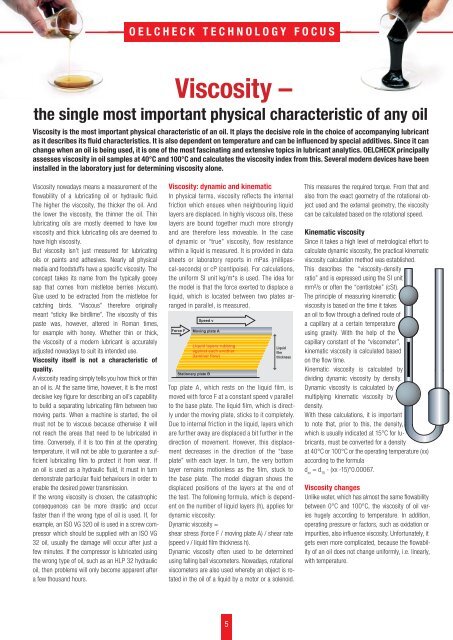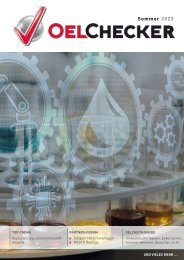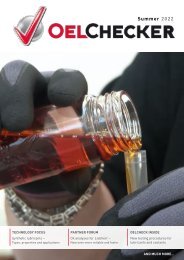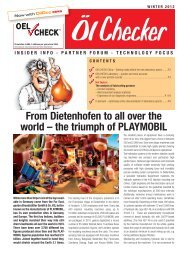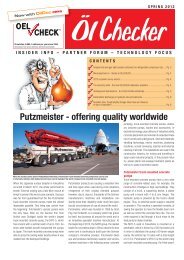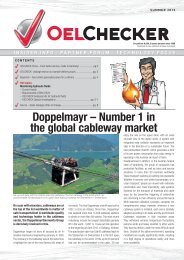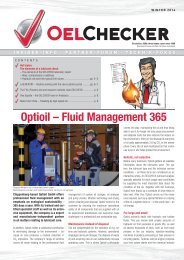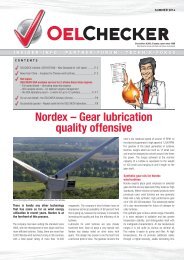OELCHECKER - Summer 2012
> Prokon wind turbines – optimum service and secure earnings > OELCHECK laboratory in the "workbench of the world" domain > The rappers from the OELCHECK alpine pastures > Optimised technology and perfect service for gas engines – August Storm > Hot Topics: > Viscosity – the single most important physical characteristic of any oil > Question time: Limit values > and much more...
> Prokon wind turbines – optimum service and secure earnings
> OELCHECK laboratory in the "workbench of the world" domain
> The rappers from the OELCHECK alpine pastures
> Optimised technology and perfect service for gas engines – August Storm
> Hot Topics:
> Viscosity – the single most important physical characteristic of any oil
> Question time: Limit values
> and much more...
Create successful ePaper yourself
Turn your PDF publications into a flip-book with our unique Google optimized e-Paper software.
OELCHECK TECHNOLOGY FOCUS<br />
Viscosity –<br />
the single most important physical characteristic of any oil<br />
Viscosity is the most important physical characteristic of an oil. It plays the decisive role in the choice of accompanying lubricant<br />
as it describes its fluid characteristics. It is also dependent on temperature and can be influenced by special additives. Since it can<br />
change when an oil is being used, it is one of the most fascinating and extensive topics in lubricant analytics. OELCHECK principally<br />
assesses viscosity in oil samples at 40°C and 100°C and calculates the viscosity index from this. Several modern devices have been<br />
installed in the laboratory just for determining viscosity alone.<br />
Viscosity nowadays means a measurement of the<br />
flowability of a lubricating oil or hydraulic fluid.<br />
The higher the viscosity, the thicker the oil. And<br />
the lower the viscosity, the thinner the oil. Thin<br />
lubricating oils are mostly deemed to have low<br />
viscosity and thick lubricating oils are deemed to<br />
have high viscosity.<br />
But viscosity isn’t just measured for lubricating<br />
oils or paints and adhesives. Nearly all physical<br />
media and foodstuffs have a specific viscosity. The<br />
concept takes its name from the typically gooey<br />
sap that comes from mistletoe berries (viscum).<br />
Glue used to be extracted from the mistletoe for<br />
catching birds. “Viscous” therefore originally<br />
meant “sticky like birdlime”. The viscosity of this<br />
paste was, however, altered in Roman times,<br />
for example with honey. Whether thin or thick,<br />
the viscosity of a modern lubricant is accurately<br />
adjusted nowadays to suit its intended use.<br />
Viscosity itself is not a characteristic of<br />
quality.<br />
A viscosity reading simply tells you how thick or thin<br />
an oil is. At the same time, however, it is the most<br />
decisive key figure for describing an oil’s capability<br />
to build a separating lubricating film between two<br />
moving parts. When a machine is started, the oil<br />
must not be to viscous because otherwise it will<br />
not reach the areas that need to be lubricated in<br />
time. Conversely, if it is too thin at the operating<br />
temperature, it will not be able to guarantee a sufficient<br />
lubricating film to protect it from wear. If<br />
an oil is used as a hydraulic fluid, it must in turn<br />
demonstrate particular fluid behaviours in order to<br />
enable the desired power transmission.<br />
If the wrong viscosity is chosen, the catastrophic<br />
consequences can be more drastic and occur<br />
faster than if the wrong type of oil is used. If, for<br />
example, an ISO VG 320 oil is used in a screw compressor<br />
which should be supplied with an ISO VG<br />
32 oil, usually the damage will occur after just a<br />
few minutes. If the compressor is lubricated using<br />
the wrong type of oil, such as an HLP 32 hydraulic<br />
oil, then problems will only become apparent after<br />
a few thousand hours.<br />
Viscosity: dynamic and kinematic<br />
In physical terms, viscosity reflects the internal<br />
friction which ensues when neighbouring liquid<br />
layers are displaced. In highly viscous oils, these<br />
layers are bound together much more strongly<br />
and are therefore less moveable. In the case<br />
of dynamic or “true” viscosity, flow resistance<br />
within a liquid is measured. It is provided in data<br />
sheets or laboratory reports in mPas (millipascal-seconds)<br />
or cP (centipoise). For calculations,<br />
the uniform SI unit kg/m*s is used. The idea for<br />
the model is that the force exerted to displace a<br />
liquid, which is located between two plates arranged<br />
in parallel, is measured.<br />
Force F<br />
Speed v<br />
Moving plate A<br />
Liquid layers rubbing<br />
against each another<br />
(laminar flow)<br />
Stationary plate B<br />
Liquid<br />
film<br />
thickness<br />
Top plate A, which rests on the liquid film, is<br />
moved with force F at a constant speed v parallel<br />
to the base plate. The liquid film, which is directly<br />
under the moving plate, sticks to it completely.<br />
Due to internal friction in the liquid, layers which<br />
are further away are displaced a bit further in the<br />
direction of movement. However, this displacement<br />
decreases in the direction of the “base<br />
plate” with each layer. In turn, the very bottom<br />
layer remains motionless as the film, stuck to<br />
the base plate. The model diagram shows the<br />
displaced positions of the layers at the end of<br />
the test. The following formula, which is dependent<br />
on the number of liquid layers (h), applies for<br />
dynamic viscosity:<br />
Dynamic viscosity =<br />
shear stress (force F / moving plate A) / shear rate<br />
(speed v / liquid film thickness h).<br />
Dynamic viscosity often used to be determined<br />
using falling ball viscometers. Nowadays, rotational<br />
viscometers are also used whereby an object is rotated<br />
in the oil of a liquid by a motor or a solenoid.<br />
This measures the required torque. From that and<br />
also from the exact geometry of the rotational object<br />
used and the external geometry, the viscosity<br />
can be calculated based on the rotational speed.<br />
Kinematic viscosity<br />
Since it takes a high level of metrological effort to<br />
calculate dynamic viscosity, the practical kinematic<br />
viscosity calculation method was established.<br />
This describes the “viscosity-density<br />
ratio” and is expressed using the SI unit<br />
mm²/s or often the “centistoke” (cSt).<br />
The principle of measuring kinematic<br />
viscosity is based on the time it takes<br />
an oil to flow through a defined route of<br />
a capillary at a certain temperature<br />
using gravity. With the help of the<br />
capillary constant of the “viscometer”,<br />
kinematic viscosity is calculated based<br />
on the flow time.<br />
Kinematic viscosity is calculated by<br />
dividing dynamic viscosity by density.<br />
Dynamic viscosity is calculated by<br />
multiplying kinematic viscosity by<br />
density.<br />
With these calculations, it is important<br />
to note that, prior to this, the density,<br />
which is usually indicated at 15°C for lubricants,<br />
must be converted for a density<br />
at 40°C or 100°C or the operating temperature (xx)<br />
according to the formula<br />
d xx<br />
= d 15<br />
- (xx -15)*0.00067.<br />
Viscosity changes<br />
Unlike water, which has almost the same flowability<br />
between 0°C and 100°C, the viscosity of oil varies<br />
hugely according to temperature. In addition,<br />
operating pressure or factors, such as oxidation or<br />
impurities, also influence viscosity. Unfortunately, it<br />
gets even more complicated, because the flowability<br />
of an oil does not change uniformly, i.e. linearly,<br />
with temperature.


